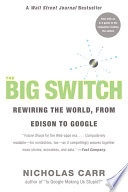

In 'The Big Switch', Nicholas Carr posits that the transition from traditional computing to cloud computing marks a significant shift in how businesses and individuals access and utilize technology. This shift parallels the historical transition from centralized power generation to decentralized electricity. Just as electricity transformed industries and daily life, cloud computing is revolutionizing how we store data, run applications, and collaborate. The book explores how this digital infrastructure is becoming a utility, allowing businesses to scale their operations without the heavy investments in physical hardware. Carr argues that this shift democratizes technology, making powerful computing resources accessible to even the smallest of companies. However, he also raises concerns about the implications of relying on a few major providers for these services, warning that it could lead to monopolistic practices and vulnerabilities in data security.
Continue readingCarr discusses how the advent of cloud computing is fundamentally altering traditional business models. Companies can now operate with reduced overhead costs, as they no longer need to invest heavily in IT infrastructure. This shift enables startups and small enterprises to compete with larger corporations by leveraging cloud services for everything from data storage to application development. The book highlights successful case studies of companies that have embraced this model, demonstrating the agility and innovation that cloud computing fosters. However, Carr also cautions that businesses must adapt to this new landscape by rethinking their strategies and operations, as the competitive advantages once held by established firms may diminish in the face of nimble, cloud-enabled competitors.
Continue readingIn 'The Big Switch', Carr emphasizes the growing importance of data and analytics in the cloud computing era. With vast amounts of data generated daily, businesses are increasingly relying on advanced analytics to derive insights and make informed decisions. The cloud provides the necessary infrastructure to store and process this data, enabling organizations to harness its power effectively. Carr discusses the emergence of big data and machine learning as transformative forces that can drive innovation and efficiency. However, he also warns of the challenges associated with data privacy and security, urging businesses to adopt robust measures to protect sensitive information while leveraging data for competitive advantage.
Continue readingCarr explores how cloud computing is reshaping the nature of work and collaboration. With remote work becoming more prevalent, cloud-based tools facilitate seamless communication and project management across teams regardless of geographic location. This shift not only enhances productivity but also allows for a more flexible work environment that can adapt to the needs of employees. Carr highlights the importance of collaboration tools and platforms that enable real-time updates and shared access to information. However, he also addresses the potential downsides of remote work, such as the blurring of boundaries between personal and professional life, and the need for organizations to foster a strong company culture in a dispersed workforce.
Continue readingAs organizations migrate to cloud computing, Carr delves into the critical issues of security and privacy. The centralized nature of cloud services raises concerns about data breaches and unauthorized access to sensitive information. Carr discusses high-profile incidents that have highlighted the vulnerabilities of cloud infrastructure and the importance of robust security measures. He emphasizes that businesses must prioritize cybersecurity as they transition to cloud-based solutions, implementing best practices to safeguard their data. Additionally, Carr raises ethical questions surrounding data ownership and the responsibility of cloud providers to protect user information, urging a reevaluation of the trust placed in these companies.
Continue readingIn the concluding chapters of 'The Big Switch', Carr speculates on the future trajectory of technology and innovation in the context of cloud computing. He envisions a landscape where technology becomes increasingly ubiquitous and integrated into everyday life. Carr discusses the potential for new business models and applications that leverage the cloud to drive innovation across various sectors. He also highlights the role of emerging technologies, such as artificial intelligence and the Internet of Things (IoT), in shaping the future of cloud computing. However, Carr cautions that this rapid pace of change necessitates continuous adaptation and learning, urging individuals and organizations to embrace a mindset of agility and resilience.
Continue readingFinally, Carr examines the broader societal implications of the shift to cloud computing. He argues that while cloud technology offers numerous benefits, it also raises questions about access and equity. As cloud services become integral to business operations and daily life, disparities in access to technology could exacerbate existing inequalities. Carr calls for a collective effort to ensure that all individuals and communities can benefit from the advantages of cloud computing. He encourages policymakers, businesses, and technologists to collaborate in creating a more inclusive digital landscape that empowers everyone to participate in the digital economy.
Continue reading